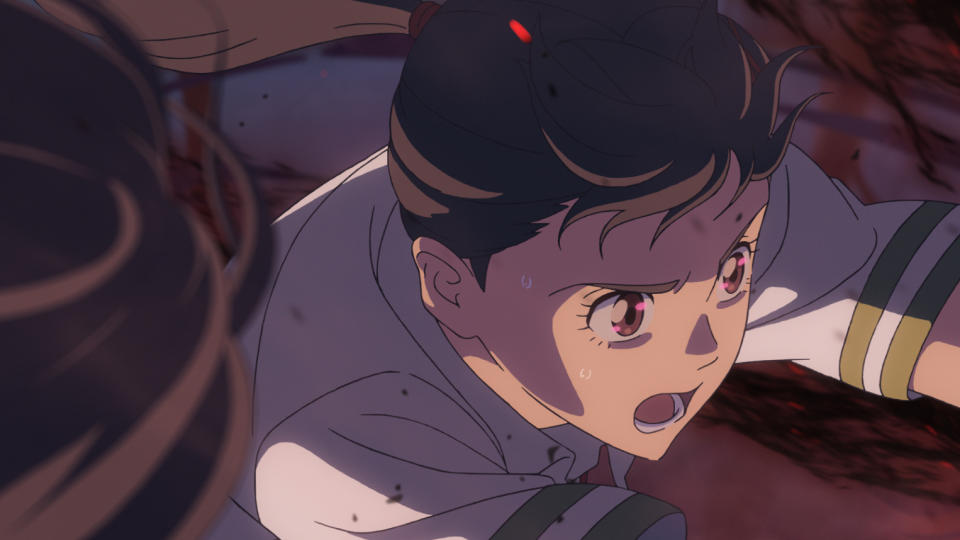‘Suzume’ Director Makoto Shinkai On Structuring A Comedic Film Before Adding “Disaster Elements”

In many of his recent films, director Makoto Shinkai has been influenced by the 2011 Tōhoku earthquake and tsunami. With Suzume, Shinkai wanted to create a film with a disaster backdrop, but have the story been structured in a more comedic way to engage a wider audience.
Suzume follows Suzume Iwato, a 17-year-old high school girl who meets a mysterious young man, Souta, that closes doors to the Ever-After before disasters can be released upon Japan. Her actions unintentionally lead to Souta being turned into a three-legged chair by the mischievous cat Daijin, leading Suzume on a journey to rescue Souta and prevent more disasters. A major comedic element Shinkai used in the film was Souta as the there-legged chair, which provided a relief to the tragedy of the film as he ran after the cat, Daijin.
More from Deadline

DEADLINE: Suzume has this special connection to the Ever-After because of a traumatic experience. Can you talk about using that as the center of the film?
MAKOTO SHINKAI: So in the film, it’s not depicted directly in a very obvious manner, but I think the audience can definitely feel that Suzume is somehow involved or affected by the 2011 disaster. The disaster itself is also not shown on camera in any direct fashion, but I think those who have somehow experienced it or have been affected by it will know exactly the scale and scope of how large it was and the sheer magnitude of this disaster. I think Suzume conveys that to the audience, in an indirect manner, with two lines of her dialogue. For example, she constantly says that she’s not afraid to die. And also when she’s talking to Souta’s grandfather, she says, “Whether you live or die is a matter of luck and there’s nothing else you can do about it.” So, I think it’s clear Suzume’s close relationship with death is really different from the average person because of the disaster and trauma she’s experienced. And I think that that is what is conveyed to the audience through her performance as a character who thought that she wasn’t afraid of death. Throughout this road trip journey she goes on in the film, she gradually begins to accept that maybe she’s afraid of death and at the very end she talks about how she wants to live.

DEADLINE: Can you talk about balancing comedy and tragedy in the film?
SHINKAI: In the very beginning, knowing that a disaster was very thematically important to the film, I knew that I had to include some form of entertainment or laughter, some comic relief for the Japanese audience to be able to be engaged. This huge disaster is a very traumatizing experience for a lot of the Japanese population, so representing it too directly wouldn’t have had the movie fulfill its mission to be entertainment. So, I tried to make a fun and engaging film first with disaster elements supplementing it, not the other way around. The idea of comedy is embedded in the entire structure of the story. I didn’t try to use comic relief as this kind of spice or accent that I would put on after the movie is complete, but rather in the very structure and architecture of the screenplay, I already considered the comedic elements.
That structural comedy led to me creating this three-legged chair, and when Souta turns into this three-legged chair, it gives Suzume some character motivation. Her motive now becomes to bring Souta back to his human form, and in the process she also has to come face to face with some of her traumatic past and sets off on her own journey. But Souta’s existence now that he’s become this three-legged chair in and of itself is comical when you imagine him just walking or being on the screen. So, I was able to achieve that constant comic relief using Souta as a chair.
DEADLINE: The 2011 Tōhoku earthquake has influenced Suzume and your past work. Are you planning on using that in your work going forward?
SHINKAI: The effects of March 11th, 2011 I think will always linger in some way. It’s definitely not over within the Japanese population or their minds. You could see that around you with the Fukushima power plant and the meltdown that could last for decades, even centuries, who knows depending on the aftermath of it. So I don’t necessarily think that March 11th will ever be over, but as far as my films are concerned, I probably won’t use that as a thematic element going forward.
That being said, while I might not use a direct reference or a metaphor referencing the disaster, the mark that incident left on me, I think I’ll always carry in some form in my filmmaking going forward. A lot of the thoughts, including Suzume’s dialogue, “Whether you live or die, it’s just a matter of luck,” and those types of ideas. It changed me in some way that it made me feel we live side by side with disaster and that your life can expire at any moment. I’ll always carry those ideas that it taught me, but I won’t reference the disaster directly.
Best of Deadline
2023 Premiere Dates For New & Returning Series On Broadcast, Cable & Streaming
2023-24 Awards Season Calendar - Dates For Oscars, Emmys, Grammys, Tonys, Guilds & More
Sign up for Deadline's Newsletter. For the latest news, follow us on Facebook, Twitter, and Instagram.


